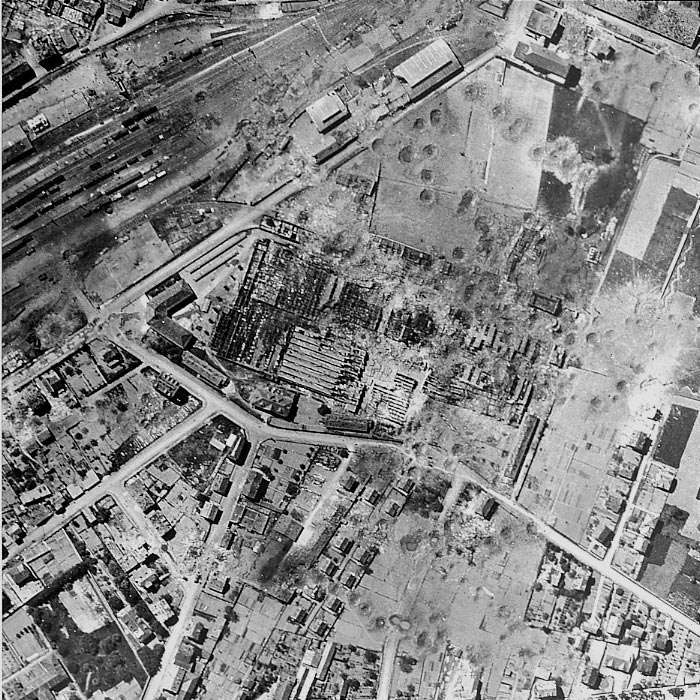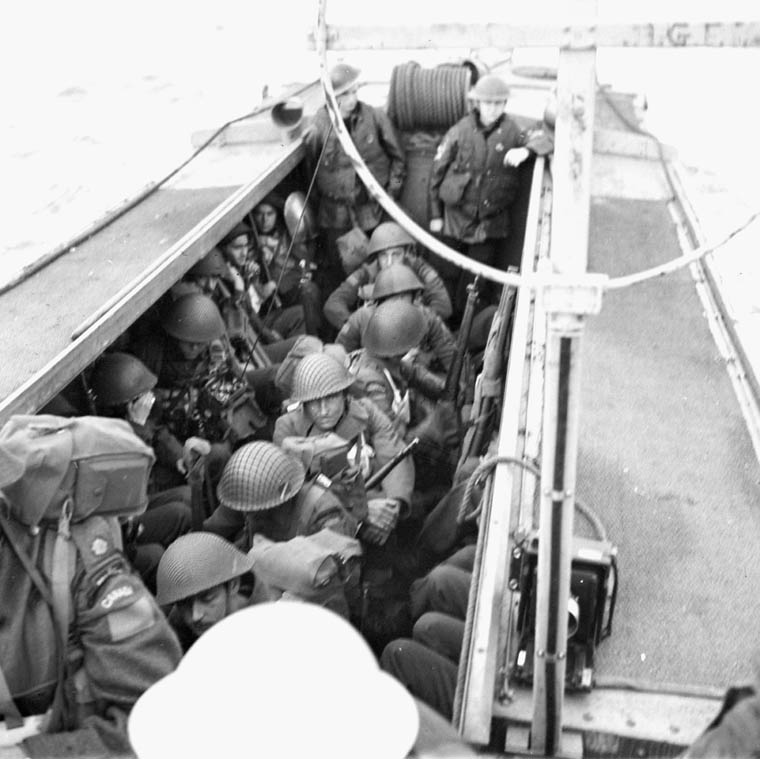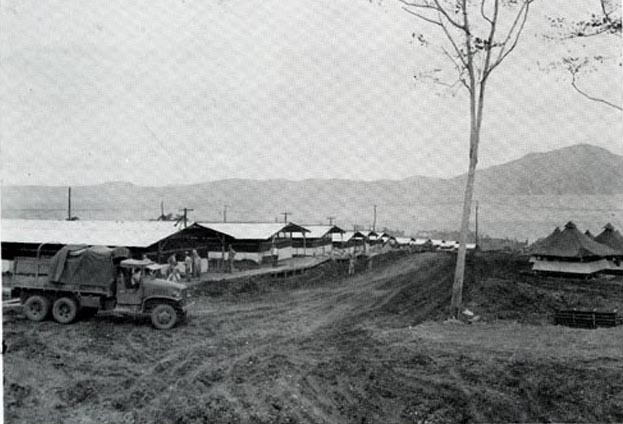Air Operations, Carolines
- 12 307th Heavy Bomb Group B-24s attack the Woleai Atoll.
- During the night, VII Bomber Command B-24s attack Wake Island.
Air Operations, CBI
BURMA- 8 7th Heavy Bomb Group B-24s sow mines around Moulmein.
- 5 B-24s sow mines off Mergui.
- 2 B-24s attack Martaban.
- 10th Air Force B-25s, P-51s, and A-31s mount more than 100 sorties against Japanese Army positions at Kanglatongbi (India), Moraing (India), the Palel area, and a bridge spannning the Uyu River.
- B-25s and fighter bombers mount more than 60 sorties in the Mogaung Valley.
- More than 20 A-31s attack dumps and Japanese Army troop concentrations in the Buthidaung area.
- 3 P-51s attack the airfield at Anisakan.
- 3 7th Heavy Bomb Group B-24s attack Nagorn Sawarn.
Air Operations, Europe
The US 8th Air Force begins a large-scale attack on French airfields, particularly those at Laon, Florennes, Thionville, St Dizier, Juvincourt, Orléans, Bourges and Avord.
RAF BOMBER COMMANDEvening Ops:
- 414 aircraft are sent to hit 7 coastal gun batteries in the Pas de Calais area. Included in this total are 206 Halifaxes, 120 Lancasters and 27 Mosquitos. 4 of the gun positions are claimed to have been hit.
- 1 Lancaster is lost bombing the Mardyck position.
- 56 Lancasters and 8 Mosquitos of No. 5 Group are sent to attack the Gnome and Rhone factory at Grennevilliers and another factory nearby.
- 5 Lancasters are lost.
- 39 Lancasters and 4 Mosquitos of No. 5 Group are sent to a small ball-bearing factory at Annecy on the French-Swiss border. Weather on the way in is very bad and only 2 Mosquito marker aircraft reach the target, but the factory is accurately bombed.
- There are no losses.
- 30 Mosquitos are sent to Berlin, 6 to Châteaudun, 20 Halifaxes and 5 Stirlings lay mines off the Dutch and French coasts, 43 aircraft are involved on Resistance operations, there are 11 Serrate and 24 Intruder patrols and 10 RCM and 12 OTU sorties.
- 2 Stirlings and 1 Halifax on Resistance flights and 1 OTU Wellington are lost.
Bomb Aiming Techniques Have Improved |
 |
BELGIUM:
- 96 2nd Bomb Division B-24s attack the Florennes/Juzaine Airdrome.
- 101 2nd Bomb Division B-24s attack the St.-Trond Airdrome.
- 63 2nd Bomb Division B-24s attack a marshalling yard at Liege.
- The Allied Expeditionary Air Force, 8th Air Force and RAF Bokmber Command open a full-scale bomber and fighte-bomber offensive against Luftwaffe bases in France and Belgium. The aim of the ongoing effort will be to drive the Luftwaffe from the OVERLORD invasion area by D-day.
- Escort for the USAAF heavy-bombers attacking targets in France, Belgium, and Luxembourg is provided by 668 VIII Fighter Command and 202 IX Fighter Command fighters. 5 Luftwaffe are downed over northern Europe in the morning.
- 7 USAAF fighter are lost with their pilots
- 37 1st Bomb Division B-17s attack the Thionville Airdrome.
- 75 1st Bomb Division B-17s attack the St.-Dizier/Robinson Airdrome.
- A total 16 2nd Bomb Division b-24s unable to attack their primary targets attack the Hody and Nivelles Airdromes.
- 71 3rd Bomb Division B-17s attack the Juvincourt Airdrome.
- 113 3rd Bomb Division B-17s attack the Laon/Athies Airdrome.
- 43 3rd Bomb Division B-17s attack the Lille/Vendeville Airdrome.
- A total of 11 3rd Bomb Division B-17s unable to attack their primary targets attack the Chievers (Belgium) and Lille/Vendeville Airdromes.
- 68 3rd Bomb Division B-24s attack the Laon/Couvron Airdrome.
- 53 1st Bomb Division B-17s attack a marshalling yard at Luxembourg City.
FRANCE:
- 40 IX Bomber Command B-26s attack bridges, V-weapons sites, and coastal-defense positions in northern France.
- 9th Air Force P-47s attack V-weapons sites.
ITALY:
- 12th Air Force B-26s attack a rail bridge and viaduct.
- XII TAC A-20s attack several fuel dumps.
- XII TAC fighter-bombers attack numerous road and rail targets in the region north of Rome.
Air Operations, New Guinea
- More than 50 V and XIII Bomber command B-24s and V Bomber Command B-25s attack the airfields at Faan and Langgoer and the Mokmer airfield on Biak, and supplies at Bosnik.
- A-20s and V Fighter Command fighter-bombers mount more than 200 sorties throughout the day against targets of opportunity between Hansa Bay and Wewak.
- 380th Heavy Bomb Group B-24s based in Australia reconnoiter the Vogelkop Peninsula and Kai Islands.
CBI
BURMAIn the NCAC area, the Chinese 198th Division, Y-Force, is ordered to move forward to a crossing site over the Salween. Salween crossings are to be made during the night of 10 or 11 May. The Japanese are driven from Ritpong, and Chinese troops remain there to mop up while Marauders move south to Lazu and block the trail. The 114th Regiment, Chinese 38th Division, overruns East Wala and Hlagyi and is approaching the 112th Regiment's outpost just north of Manpin.
CHINAJapanese troops capture Lushan completely cutting the Peking-Hankow rail line.
[China
Japanese troops capture Lushan completely cutting the Peking-Hankow rail line.
[Eastern Front
After a 24-day seige, Sevastopol finally falls to the Red Army. Moscow fires 24 salvoes from 324 guns as Tolbukhin's troops capture the fortress of Sevastopol. The remainder of the German garrison retreats toward Cape Kersonessky where evacuations are still being carried out. German rearguards hold out for 3 days in defense of the points at which the remains of the army are embarking. The whole of the Crimea is now once more in Russian hands.
There is now another lull on the Russian front. German Army Group North under Georg Lindemann still holds Narva and the west bank of Lake Peipus, covering the Baltic countries. Army Group Center still occupies Vitebsk, with salients on both sides of the Dvina, and is still east of the Dniepr in the Orsha and Mogilev areas. The Germans are still 60 miles from Smolensk, as if they intended to attack Moscow. But in the south their front has collapsed.
The Russians have liberated the Ukraine and penetrated into Rumania and Poland, and are now only 30 miles from Brest Litovsk. And they have reached the frontier of Czechoslovakia. They are at the foothills of the Carpathians, they have crossed the Dniestr and the Prut, they have invaded Bukovina and Bessarabia. And behind the German lines the partisans - at least 250,000 of them - are operating, supplied at night by some 200 aircraft. Hitler calls for increased war production. Boys of 18 are being drafted into the armed forces.
SOUTHERN SECTORSome 50,000 German troops pack the Khersonnes Peninsula, pounded by guns and aircraft of the 4th Ukrainian Front. The last rearguards inside Sevastopol are destroyed.
[Mediterranean
The US submarine chaser PC-558 is sunk by a submarine torpedo from U-230 near Palermo, Italy.
[![]()
![]() |
| ![]()
![]() ]
]
New Guinea
Over the next few days there is constant skirmishing with occasional fierce engagements around the US beachheads at Hollandia, but the Japanese forces are ill-supplied and weak and achieve little.
Nyaparake Force patrols, using a coastal trail and an inland one paralleling it, advance almost 5,000 yards east of the Dandriwad River against some resistance and retire to Babiang at dusk.
Planners meeting at ALAMO Force headquarters decide to undertake the Wakde-Biak operation as proposed by Gen MacArthur with forces originally assigned to the Wakde-Sarmi operation. D-Day for Wakde is set for 17 May and Z-Day for Biak for 27 May.
[![]()
![]() |
| ![]()
![]() ]
]
Images from May 9, 1944
|
|

